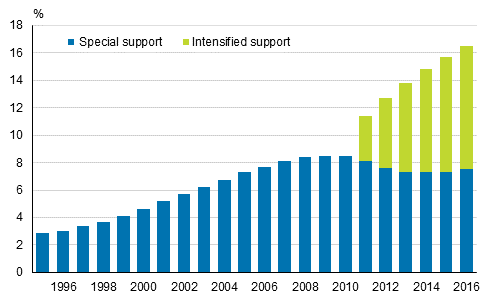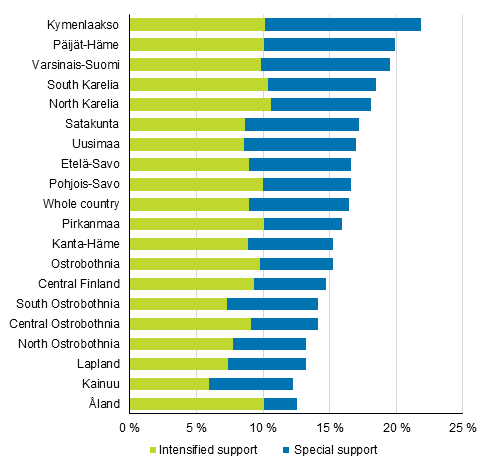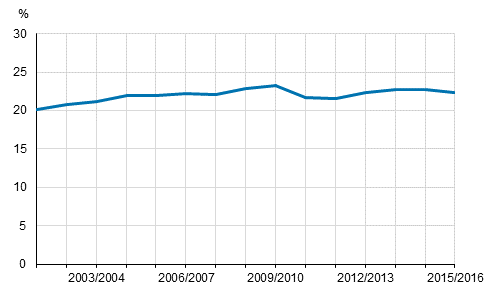Published: 13 June 2017
One in six comprehensive school pupils received intensified or special support
Intensified or special support was received by 16.4 per cent of comprehensive school pupils in autumn 2016. Intensified support was received by 49,400, or 9.0 per cent of comprehensive school pupils and special support by 41,000, or 7.5 per cent of comprehensive school pupils. The number of pupils in intensified support grew from the previous year by 0.6 percentage points and in special support by 0.2 percentage points. These data derive from Statistics Finland’s education statistics.
Share of comprehensive school pupils having received intensified or special support among all comprehensive school pupils 1995–2016, % 1)

1) Pupils accepted or transferred to special education before 2011 have been regarded as equal to pupils having received special support.
Among the recipients of intensified support, 65 per cent were boys and 35 per cent girls. Seventy per cent of the recipients of special support were boys and 30 per cent girls. In autumn 2016, a total of 550,200 comprehensive school pupils were in pre-primary, basic and post-basic education of the comprehensive school, 51 per cent of whom were boys and 49 per cent girls.
The statistics on special education in comprehensive schools contain data primarily on intensified and special support. The statistics also include data on general support as concerns part-time special education.
The database tables connected to the statistics on special education and the database tables related to statistics on pre-primary and comprehensive education allow examination of support received by pupils by area and place of implementation of teaching, for example. Data on special education in vocational education are collected at the end of the text section of this release and in Appendix table 9.
Intensified support increased in all Mainland Finland regions
In 2016, intensified support was arranged for more pupils than in the year before in all regions except ┼land. In several Mainland regions, intensified support was received by over 10 per cent of pupils. In previous years, the number of pupils having received intensified support was not over 10 per cent in any Mainland Finland regions. In relative terms, the amount of intensified support increased most in South Karelia, Kymenlaakso and Varsinais-Suomi, in all of them the amount was over one percentage point higher than in the previous year. The share of pupils having received intensified support was highest in North Karelia and lowest in Kainuu. In Mainland Finland, the share of pupils having received intensified support in all pupils was 6 to 11 per cent in different regions.
Share of comprehensive school pupils having received intensified or special support by region 2016, %

In Mainland Finland regions, the share of pupils having received special support in all comprehensive school pupils was 5 to 12 per cent. The share of pupils having received special support was lowest in Central Ostrobothnia and highest in Kymenlaakso. In ┼land, the share of pupils receiving special support was under three per cent.
The share of comprehensive school pupils receiving intensified or special support varies between regions. The combined share of those receiving intensified support was biggest in Kymenlaakso, where 22 per cent of pupils received intensified or special support. The combined shares of those receiving support were smallest in Kainuu, Lapland and North Ostrobothnia.
Three out of four pupils in intensified support received part-time special education
Seventy-five per cent of the pupils who received intensified support in autumn 2016 received part-time special education, 57 per cent remedial teaching, and 38 per cent special needs assistance and/or interpretation services. Thirty-eight per cent of the pupils who received special support received part-time special education, 35 per cent received remedial teaching, and 58 per cent special needs assistance and/or interpretation services.
Twenty-six per cent of the pupils receiving special support had extended duration of compulsory education.
Among the recipients of special support, 38 per cent received all education in a special education group and 20 per cent received all education in a general education group. The remaining 42 per cent received part of the education in a general education group and part in a special education group.
Over one-half of pupils having received special support studied fully according to the general syllabus
Fifty-one per cent of the pupils having received special support in basic and post-basic education of the comprehensive school studied general education syllabuses in all subjects in autumn 2016. The share of those studying according to the general syllabus has grown yearly; its share was 44 per cent in 2011, it was 46 per cent in 2013 and 49 per cent in 2015.
Thirteen per cent of the pupils having received special support in 2016 had individualised syllabuses for one subject, 12 per cent for two to three subjects, and 19 per cent for four or more subjects. Five per cent of the pupils receiving special support studied according to functional skill areas. The teaching can be arranged according to functional skill areas if it cannot be arranged by subject syllabuses due to the pupil's severe disability or illness.
Twenty-two per cent of comprehensive school pupils received part-time special education in the school year 2015 to 2016
In the school year 2015 to 2016, altogether 122,200 comprehensive school pupils received part-time special education, which was 22 per cent of comprehensive school pupils in autumn 2015. The share has fallen a little from the previous school year.
Share of comprehensive school pupils having received part-time special education among all comprehensive school pupils in academic years 2001/2002 to 2015/2016, %

In autumn 2015, part-time special education was included in intensified support for 34,400 pupils and in special support for 14,900 pupils. By subtracting we can conclude that around 73,000, or 60 per cent, of the 122,200 pupils having received part-time special education in the school year 2015 to 2016 received part-time special education as general support.
According to the available statistics, at least 29 per cent of the number of pupils in comprehensive school received some kind of support in the school year 2015 to 2016. The share has remained unchanged for the past three years. A total of 158,800 students received intensified support, special support or part-time special education as general support in the school year 2015 to 2016.
Number of vocational education students having received special education has continued growing
The number of students in vocational education leading to a qualification having received special education has grown at least from 2004 onwards, when the production of these statistics started: 12,500 pupils received special education in 2004, 18,300 in 2009, and 24,300 in 2015. The share of all students having received special education in all students in vocational education leading to a qualification was in the same years five, six and nine per cent.
In 2015, there were 124,220 students in vocational education for young people (curriculum-based basic vocational education provided by educational institutions), of whom 18 per cent were special education students. Nineteen per cent of male students and 17 per cent of female students were special education students. In all, 57 per cent of special education students were men.
Most special education students (86%) in vocational education for young people were studying in vocational education institutions. Thirteen per cent of special education students attended special vocational education institutions and around one per cent other educational institutions providing vocational education.
Eighty-three per cent of special education students in vocational education for young people were studying in the same groups (integrated) with other students.
Source: Education. Statistics Finland
Inquiries: Heli Hiltunen 029 551 3314, koulutustilastot@stat.fi
Director in charge: Jari Tarkoma
Publication in pdf-format (282.8 kB)
- Tables
-
Tables in databases
Pick the data you need into tables, view the data as graphs, or download the data for your use.
Appendix tables
- Appendix table 1. Comprehensive school pupils having received intensified or special support, 2016 (13.6.2017)
- Appendix table 2. Part-time special education, remedial teaching, and special needs assistance and interpretation services received by comprehensive school pupils having received intensified or special support, 2016 1) (13.6.2017)
- Apprendix table 3. Comprehensive school puplis having received intensified support 2011 - 2016 (13.6.2017)
- Apprendix table 4. Comprehensive school pupils having received special support by duration of compulsory education, 2016 (13.6.2017)
- Appendix table 5. Comprehensive school pupils having received special support by place of provision of teaching, 2016 (13.6.2017)
- Appendix table 6. Pupils having received special support on grades 1-9 and during additional education of comprehensive school by subject syllabus, 2016 (13.6.2017)
- Appendix table 7. Comprehensive school pupils having received special support, 1995 - 2016 1) (13.6.2017)
- Appendix table 8. Comprehensive school pupils having received part-time special education from academic year 2001/2002 to academic year 2015/2016 (13.6.2017)
- Appendix table 9. Students of special vocational education by place of provision of teaching, 2004 - 2015 (13.6.2017)
- Appendix table 10. Comprehensive school pupils having received intensified or special support by region in 2016 (13.6.2017)
Updated 13.6.2017
Official Statistics of Finland (OSF):
Support for learning [e-publication].
ISSN=1799-1617. 2016. Helsinki: Statistics Finland [referred: 19.12.2025].
Access method: http://stat.fi/til/erop/2016/erop_2016_2017-06-13_tie_001_en.html

